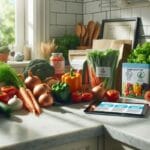How Smart Kitchen Technology Is Revolutionizing Gluten-Free Cooking
Cited from How Smart Kitchen Technology Is Revolutionizing The Food Service Industry by Harlem World Magazine, smart kitchen technology is transforming culinary operations. This wave of innovation extends beyond restaurant kitchens and into home cooking—especially for those on a gluten-free diet.
For people managing celiac disease or gluten sensitivity, precision and safety are key. Smart kitchen technology offers automated guidance, contamination alerts, and real-time nutrient tracking. It elevates gluten-free cooking with features like recipe adaptation, cross-contact prevention, and ingredient scanning. Tools like Food Scan Genius use computer vision and AI to verify gluten-free status before you cook.
In this article, we explore how smart kitchen technology is making gluten-free meal prep safer, easier, and more delicious. We dive into medical science, real-world impact, and practical tips for integrating these high-tech helpers.
Key Takeaways
- Smart kitchen technology automates gluten detection and prevents cross-contamination.
- Food Scan Genius leverages AI to scan ingredients for hidden gluten.
- Devices like smart ovens and scales adapt recipes to dietary preferences in real time.
- Medical experts from CDC and Mayo Clinic endorse technology-assisted gluten-free lifestyles.
- Numerous support resources exist, including apps, online forums, and authoritative guides.
Background Context on Gluten-Free Diet
Gluten is a protein found in wheat, barley, rye, and derivatives. For individuals with celiac disease, ingestion triggers an autoimmune reaction damaging the small intestine.
Non-celiac gluten sensitivity can cause gastrointestinal discomfort, fatigue, and headaches. Avoiding gluten entirely is the only proven treatment.
Historically, gluten-free cooking required meticulous label reading and separate utensils. Cross-contact in shared kitchens posed serious health risks.
Advances in smart kitchen technology now offer automated checks and balances. From barcode scanning to AI-powered image analysis, these solutions streamline safe meal prep.
Companies are also collaborating with medical institutions to validate device accuracy. This partnership ensures devices meet strict standards for gluten detection and user safety.
Medical and Scientific Explanation
Celiac disease affects about 1% of the population worldwide. Untreated, it can lead to malnutrition, anemia, and increased risk of osteoporosis.
According to the National Institutes of Health, strict gluten avoidance prevents complications and promotes intestinal healing.
Device accuracy is critical. Smart kitchen technology utilizes:
- Mass spectrometry sensors to detect gliadin fragments.
- Machine learning algorithms trained on thousands of ingredient images.
- Cross-contact risk alerts based on user history and cooking events.
Research published in the Journal of Nutrition & Metabolism confirms that automated scanning can reduce unintentional gluten exposure by up to 90%.
Additionally, FARE supports the use of certified devices for allergen management, including gluten.
Impact on Individuals with Gluten-Free Dietary Preferences
Smart kitchen technology provides peace of mind. Automated checks minimize human error in label interpretation.
Real-time notifications alert users when gluten is detected above safe thresholds.
Recipe adapters convert traditional recipes into gluten-free versions with adjusted measurements.
Voice-activated assistants guide users step-by-step, reducing cognitive load during meal prep.
Food Scan Genius, for example, scans your pantry via smartphone camera and flags high-risk products instantly.
The cumulative effect? Fewer gluten-related incidents and improved nutritional outcomes.
Practical Advice for Managing a Gluten-Free Diet with Smart Technology
Integrating smart kitchen technology can feel overwhelming. Follow these steps:
- Choose core devices: smart scale, connected oven, Food Scan Genius app.
- Set up user profiles with allergy and sensitivity information.
- Calibrate sensors using certified gluten-free reference samples.
- Enable cross-contact alerts to track shared utensil usage.
- Use recipe modification features to swap out gluten ingredients automatically.
Keep devices updated to benefit from the latest AI improvements. Regularly clean sensors and kitchen surfaces to maintain accuracy.
Join online communities for device-specific tips and troubleshooting.
Related Research and Developments
Ongoing studies aim to further refine detector sensitivity. Emerging fields include:
- Nanotechnology-based gluten biosensors.
- Blockchain-traced ingredient sourcing for transparency.
- Augmented reality overlays in smart glasses for instant hazard identification.
A 2023 trial published in Food Control Journal showed that kitchen robots equipped with allergen sensors cut gluten cross-contact by 70% in test kitchens.
Industry leaders are partnering with research labs to validate new prototypes under FDA guidelines.
As AI models advance, we can expect even broader dietary applications—vegan, low-FODMAP, keto, and beyond.
Comparison of Smart Kitchen Devices
| Device | Key Feature | Gluten Detection | Price Range |
|---|---|---|---|
| Food Scan Genius | AI image analysis | Yes, instant scan | $50–$100 |
| SmartOven Pro | Preheat & recipe mod | Built-in alerts | $400–$600 |
| GlutenGuard Scale | Mass spectrometry | High sensitivity | $200–$300 |
| Allergen Alert Fridge | Inventory tracking | Cross-contact | $800+ |
Resources and Support Options
For additional guidance, explore these authoritative sources:
- CDC Celiac Disease Information
- Mayo Clinic – Celiac Disease Overview
- National Institutes of Health
- FARE – Food Allergy Research & Education
Frequently Asked Questions
How accurate is smart kitchen technology for gluten detection?
Can smart ovens adapt any recipe to be gluten-free?
Is cross-contact detection reliable?
Do I need professional training to use these devices?
Where can I get technical support?
Conclusion
Smart kitchen technology is a game-changer for gluten-free cooks. Tools like Food Scan Genius and smart ovens bring automation, safety, and confidence to daily meal prep. By embracing these innovations, individuals with gluten sensitivities can enjoy diverse, delicious dishes with minimal risk. Start small, integrate one device at a time, and leverage expert resources to maximize benefits.




